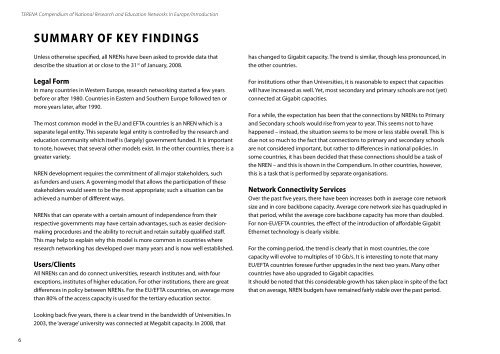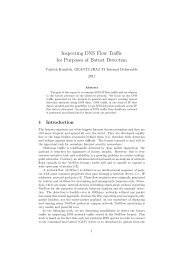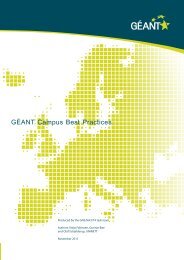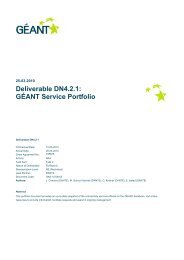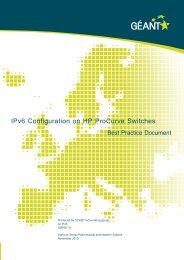TERENA COMPENDIUM - Géant
TERENA COMPENDIUM - Géant
TERENA COMPENDIUM - Géant
You also want an ePaper? Increase the reach of your titles
YUMPU automatically turns print PDFs into web optimized ePapers that Google loves.
<strong>TERENA</strong> Compendium of National Research and Education Networks In Europe /IntroductionSUMMARY OF KEY FINDINGSUnless otherwise specified, all NRENs have been asked to provide data thatdescribe the situation at or close to the 31 st of January, 2008.Legal FormIn many countries in Western Europe, research networking started a few yearsbefore or after 1980. Countries in Eastern and Southern Europe followed ten ormore years later, after 1990.The most common model in the EU and EFTA countries is an NREN which is aseparate legal entity. This separate legal entity is controlled by the research andeducation community which itself is (largely) government funded. It is importantto note, however, that several other models exist. In the other countries, there is agreater variety.NREN development requires the commitment of all major stakeholders, suchas funders and users. A governing model that allows the participation of thesestakeholders would seem to be the most appropriate; such a situation can beachieved a number of different ways.NRENs that can operate with a certain amount of independence from theirrespective governments may have certain advantages, such as easier decisionmakingprocedures and the ability to recruit and retain suitably qualified staff.This may help to explain why this model is more common in countries whereresearch networking has developed over many years and is now well established.Users/ClientsAll NRENs can and do connect universities, research institutes and, with fourexceptions, institutes of higher education. For other institutions, there are greatdifferences in policy between NRENs. For the EU/EFTA countries, on average morethan 80% of the access capacity is used for the tertiary education sector.has changed to Gigabit capacity. The trend is similar, though less pronounced, inthe other countries.For institutions other than Universities, it is reasonable to expect that capacitieswill have increased as well. Yet, most secondary and primary schools are not (yet)connected at Gigabit capacities.For a while, the expectation has been that the connections by NRENs to Primaryand Secondary schools would rise from year to year. This seems not to havehappened – instead, the situation seems to be more or less stable overall. This isdue not so much to the fact that connections to primary and secondary schoolsare not considered important, but rather to differences in national policies. Insome countries, it has been decided that these connections should be a task ofthe NREN – and this is shown in the Compendium. In other countries, however,this is a task that is performed by separate organisations.Network Connectivity ServicesOver the past five years, there have been increases both in average core networksize and in core backbone capacity. Average core network size has quadrupled inthat period, whilst the average core backbone capacity has more than doubled.For non-EU/EFTA countries, the effect of the introduction of affordable GigabitEthernet technology is clearly visible.For the coming period, the trend is clearly that in most countries, the corecapacity will evolve to multiples of 10 Gb/s. It is interesting to note that manyEU/EFTA countries foresee further upgrades in the next two years. Many othercountries have also upgraded to Gigabit capacities.It should be noted that this considerable growth has taken place in spite of the factthat on average, NREN budgets have remained fairly stable over the past period.Looking back five years, there is a clear trend in the bandwidth of Universities. In2003, the ‘average’ university was connected at Megabit capacity. In 2008, that6


